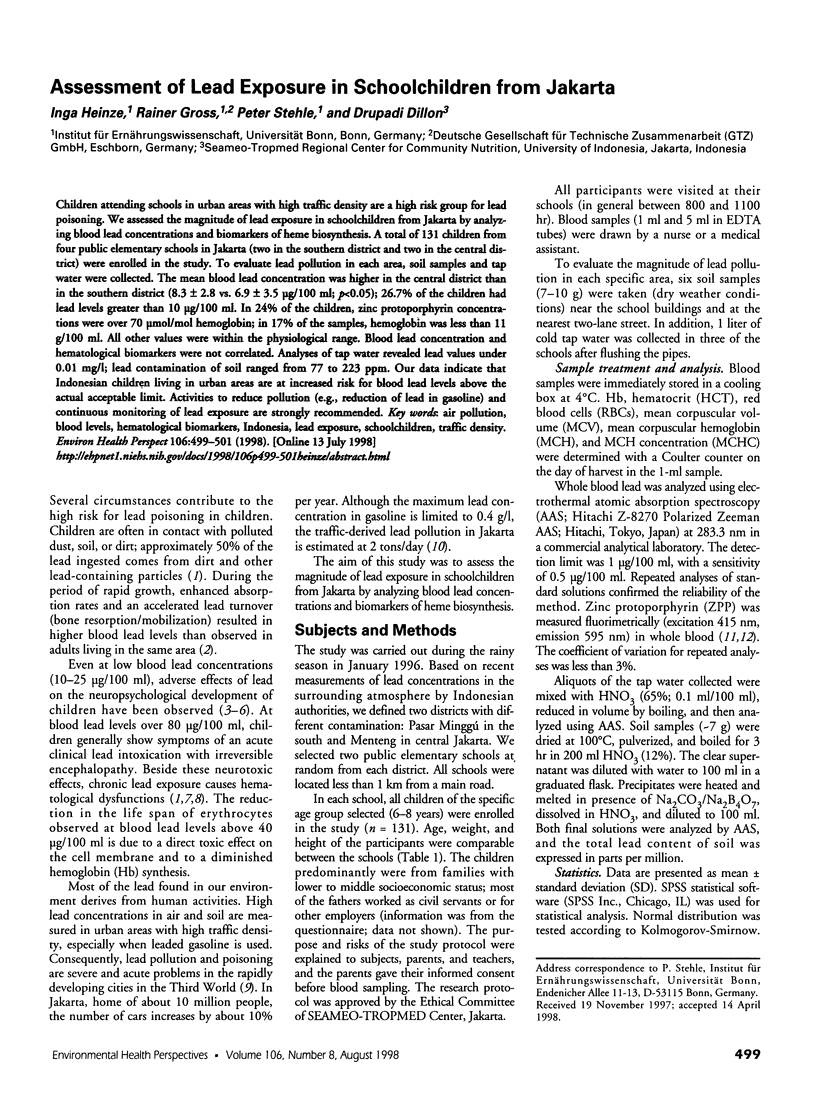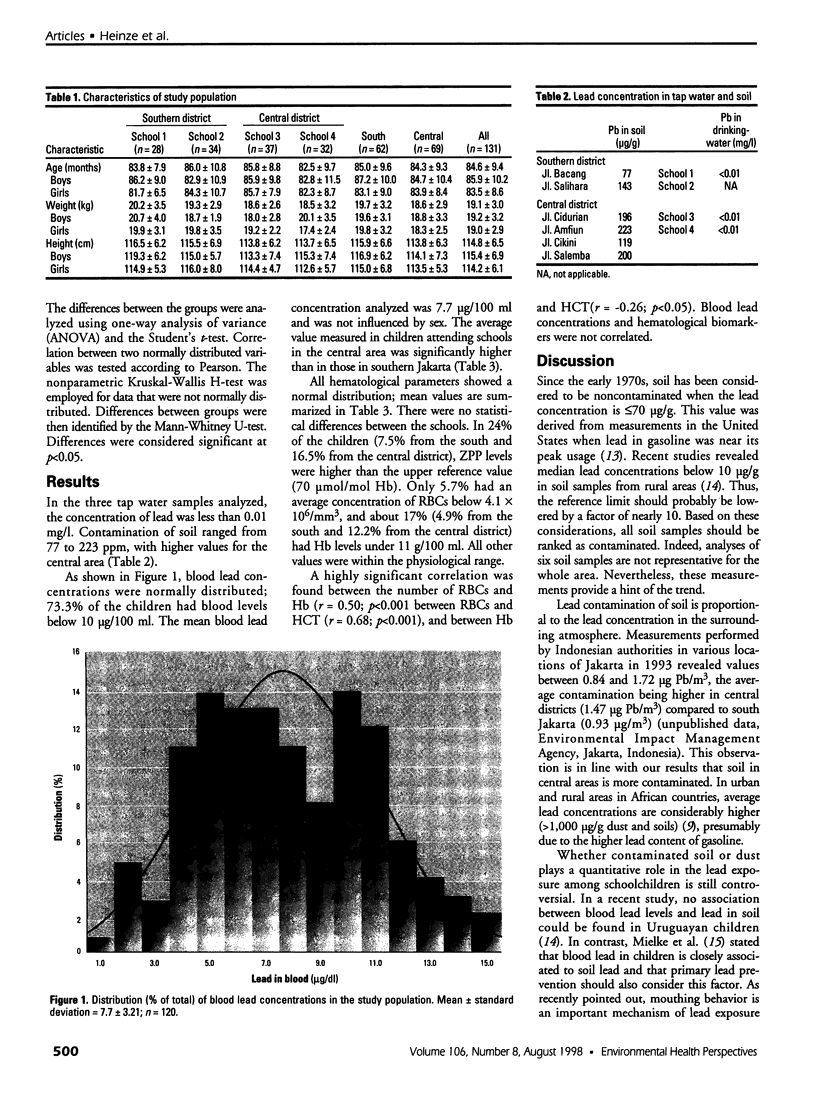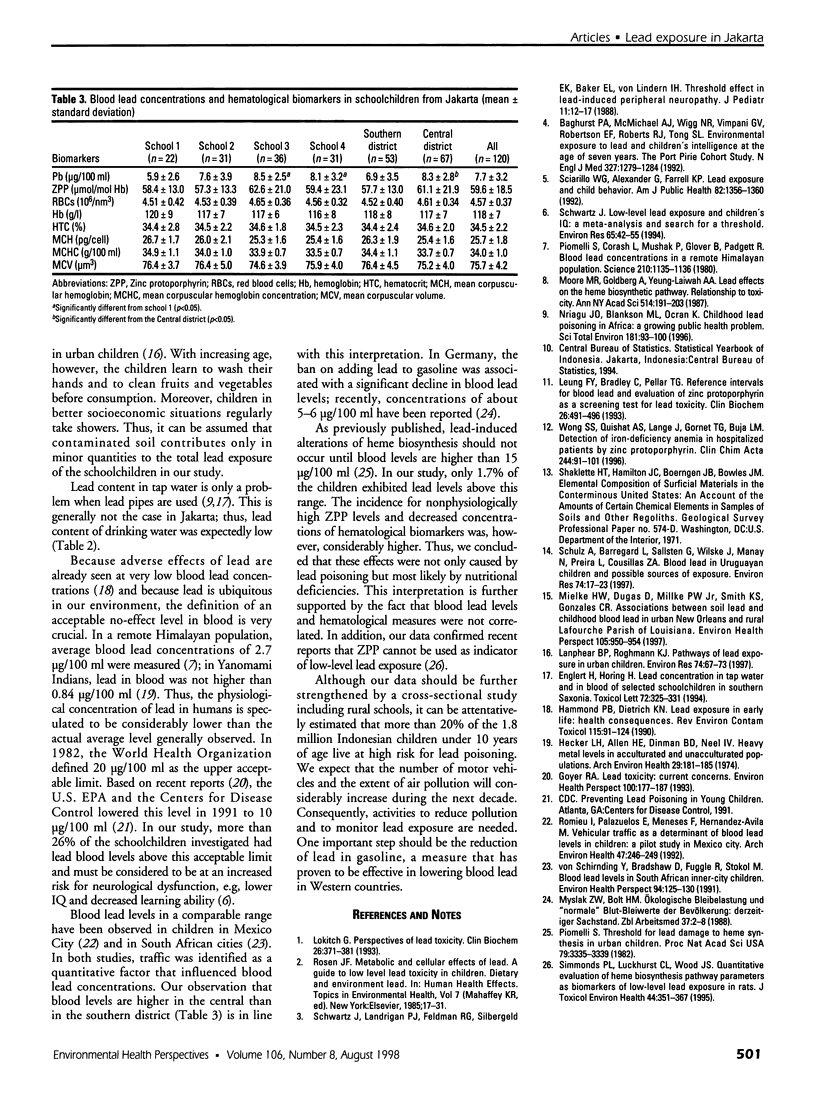Abstract
Children attending schools in urban areas with high traffic density are a high risk group for lead poisoning. We assessed the magnitude of lead exposure in schoolchildren from Jakarta by analyzing blood lead concentrations and biomarkers of heme biosynthesis. A total of 131 children from four public elementary schools in Jakarta (two in the southern district and two in the central district) were enrolled in the study. To evaluate lead pollution in each area, soil samples and tap water were collected. The mean blood lead concentration was higher in the central district than in the southern district (8.3 +/- 2.8 vs. 6.9 +/- 3.5 microg/100 ml; p<0.05); 26.7% of the children had lead levels greater than 10 microg/100 ml. In 24% of the children, zinc protoporphyrin concentrations were over 70 micromol/mol hemoglobin; in 17% of the samples, hemoglobin was less than 11 g/100 ml. All other values were within the physiological range. Blood lead concentration and hematological biomarkers were not correlated. Analyses of tap water revealed lead values under 0. 01 mg/l; lead contamination of soil ranged from 77 to 223 ppm. Our data indicate that Indonesian children living in urban areas are at increased risk for blood lead levels above the actual acceptable limit. Activities to reduce pollution (e.g., reduction of lead in gasoline) and continuous monitoring of lead exposure are strongly recommended.
Full text
PDF


Images in this article
Selected References
These references are in PubMed. This may not be the complete list of references from this article.
- Baghurst P. A., McMichael A. J., Wigg N. R., Vimpani G. V., Robertson E. F., Roberts R. J., Tong S. L. Environmental exposure to lead and children's intelligence at the age of seven years. The Port Pirie Cohort Study. N Engl J Med. 1992 Oct 29;327(18):1279–1284. doi: 10.1056/NEJM199210293271805. [DOI] [PubMed] [Google Scholar]
- Englert N., Höring H. Lead concentration in tap-water and in blood of selected schoolchildren in southern Saxonia. Toxicol Lett. 1994 Jun;72(1-3):325–331. doi: 10.1016/0378-4274(94)90044-2. [DOI] [PubMed] [Google Scholar]
- Goyer R. A. Lead toxicity: current concerns. Environ Health Perspect. 1993 Apr;100:177–187. doi: 10.1289/ehp.93100177. [DOI] [PMC free article] [PubMed] [Google Scholar]
- Hammond P. B., Dietrich K. N. Lead exposure in early life: health consequences. Rev Environ Contam Toxicol. 1990;115:91–124. doi: 10.1007/978-1-4612-3416-6_3. [DOI] [PubMed] [Google Scholar]
- Hecker L. H., Allen H. E., Dinman B. D. Heavy metal levels in acculturated and unacculturated populations. Arch Environ Health. 1974 Oct;29(4):181–185. doi: 10.1080/00039896.1974.10666565. [DOI] [PubMed] [Google Scholar]
- Lanphear B. P., Roghmann K. J. Pathways of lead exposure in urban children. Environ Res. 1997;74(1):67–73. doi: 10.1006/enrs.1997.3726. [DOI] [PubMed] [Google Scholar]
- Leung F. Y., Bradley C., Pellar T. G. Reference intervals for blood lead and evaluation of zinc protoporphyrin as a screening test for lead toxicity. Clin Biochem. 1993 Dec;26(6):491–496. doi: 10.1016/0009-9120(93)80014-l. [DOI] [PubMed] [Google Scholar]
- Lockitch G. Perspectives on lead toxicity. Clin Biochem. 1993 Oct;26(5):371–381. doi: 10.1016/0009-9120(93)90113-k. [DOI] [PubMed] [Google Scholar]
- Mielke H. W., Dugas D., Mielke P. W., Jr, Smith K. S., Gonzales C. R. Associations between soil lead and childhood blood lead in urban New Orleans and rural Lafourche Parish of Louisiana. Environ Health Perspect. 1997 Sep;105(9):950–954. doi: 10.1289/ehp.97105950. [DOI] [PMC free article] [PubMed] [Google Scholar]
- Moore M. R., Goldberg A., Yeung-Laiwah A. A. Lead effects on the heme biosynthetic pathway. Relationship to toxicity. Ann N Y Acad Sci. 1987;514:191–203. doi: 10.1111/j.1749-6632.1987.tb48774.x. [DOI] [PubMed] [Google Scholar]
- Nriagu J. O., Blankson M. L., Ocran K. Childhood lead poisoning in Africa: a growing public health problem. Sci Total Environ. 1996 Mar 15;181(2):93–100. doi: 10.1016/0048-9697(95)04954-1. [DOI] [PubMed] [Google Scholar]
- Piomelli S., Corash L., Corash M. B., Seaman C., Mushak P., Glover B., Padgett R. Blood lead concentrations in a remote Himalayan population. Science. 1980 Dec 5;210(4474):1135–1137. doi: 10.1126/science.7444442. [DOI] [PubMed] [Google Scholar]
- Piomelli S., Seaman C., Zullow D., Curran A., Davidow B. Threshold for lead damage to heme synthesis in urban children. Proc Natl Acad Sci U S A. 1982 May;79(10):3335–3339. doi: 10.1073/pnas.79.10.3335. [DOI] [PMC free article] [PubMed] [Google Scholar]
- Romieu I., Palazuelos E., Meneses F., Hernandez-Avila M. Vehicular traffic as a determinant of blood-lead levels in children: a pilot study in Mexico City. Arch Environ Health. 1992 Jul-Aug;47(4):246–249. doi: 10.1080/00039896.1992.9938356. [DOI] [PubMed] [Google Scholar]
- Schwartz J., Landrigan P. J., Feldman R. G., Silbergeld E. K., Baker E. L., Jr, von Lindern I. H. Threshold effect in lead-induced peripheral neuropathy. J Pediatr. 1988 Jan;112(1):12–17. doi: 10.1016/s0022-3476(88)80111-2. [DOI] [PubMed] [Google Scholar]
- Schwartz J. Low-level lead exposure and children's IQ: a meta-analysis and search for a threshold. Environ Res. 1994 Apr;65(1):42–55. doi: 10.1006/enrs.1994.1020. [DOI] [PubMed] [Google Scholar]
- Schütz A., Barregård L., Sällsten G., Wilske J., Manay N., Pereira L., Cousillas Z. A. Blood lead in Uruguayan children and possible sources of exposure. Environ Res. 1997;74(1):17–23. doi: 10.1006/enrs.1997.3742. [DOI] [PubMed] [Google Scholar]
- Sciarillo W. G., Alexander G., Farrell K. P. Lead exposure and child behavior. Am J Public Health. 1992 Oct;82(10):1356–1360. doi: 10.2105/ajph.82.10.1356. [DOI] [PMC free article] [PubMed] [Google Scholar]
- Simmonds P. L., Luckhurst C. L., Woods J. S. Quantitative evaluation of heme biosynthetic pathway parameters as biomarkers of low-level lead exposure in rats. J Toxicol Environ Health. 1995 Mar;44(3):351–367. doi: 10.1080/15287399509531964. [DOI] [PubMed] [Google Scholar]
- Wong S. S., Qutishat A. S., Lange J., Gornet T. G., Buja L. M. Detection of iron-deficiency anemia in hospitalized patients by zinc protoporphyrin. Clin Chim Acta. 1996 Jan 15;244(1):91–101. doi: 10.1016/0009-8981(95)06200-9. [DOI] [PubMed] [Google Scholar]
- von Schirnding Y., Bradshaw D., Fuggle R., Stokol M. Blood lead levels in South African inner-city children. Environ Health Perspect. 1991 Aug;94:125–130. doi: 10.1289/ehp.94-1567937. [DOI] [PMC free article] [PubMed] [Google Scholar]



